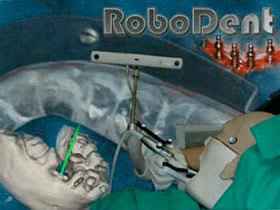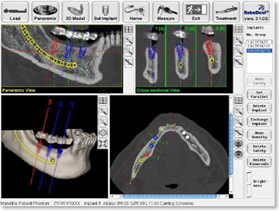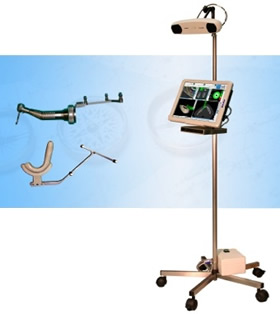 Due to their distinctive advantages, dental implants have been successfully applied for over 40 years and acknowledged as a safe way of treatment.
Due to their distinctive advantages, dental implants have been successfully applied for over 40 years and acknowledged as a safe way of treatment.
The optimal placement of an implant has to meet two major criteria: On the one hand, the surgical requirement is to place the implant into dense bone, in safe distance to a nerve or other sensitive structures. On the other hand, the aesthetic demand is to achieve an implant placement directly under the crown in a way that allows the dental implant to stay completely invisible. Modern dental interventions - especially in dental implantology - increasingly rely on so-called 3D (three-dimensional) images of the jaw.
 Advantages of RoboDent.
Advantages of RoboDent.- 3D planning on the screen allows quick and easy implant positioning, taking surgical and aesthetical considerations into account.
- Bone density measurement along the implant thread. Measurement of bone density and X-Ray absorption density along the implant thread allow a first judgment of implant stability.
- Security warnings in case an implant is planned too close to the nerve.
- The RoboDent DICOM-Viewer, images in DICOM format generated by CD, DVT etc. can be loaded and displayed in a three-dimensional fashion on the screen. The "virtual jaw" on the screen can be rotated easily and analyzed at from all perspectives of choice. Additionally, the surgeon can create a "virtual OPG" as a panoramic view of the patient's anatomy.
- RoboDent implant database. The implant library is constantly being updated. - The Implant library: More than 1000 different implants of all leading manufacturers.
- The Implant library: More than 1000 different implants of all leading manufacturers.
- RoboDent NaviPanel is the most advanced navigation system. Freehand navigation allows for optimal cooling of the bone With a weight of 10 kg, the system can be easily integrated even into the smallest medical practice. Its display and CD-ROM drive can be placed onto a table and be used as a docking station.
- The NaviBase navigation platform integrates each component of a navigation system into a rollable stand. The system can be operated by a 19'' touch screen display, a 3D/6D input device as well as a mouse. Patient data can be loaded and saved onto CD-ROM discs. A minidisplay is capable of delivering all necessary information directly to the sites, thus reducing the viewing angle between patient and display. The compact system case is made out of white acrylic and brushed aluminum, which is robust and durable.
- The Micro-Sphere-Reflectors: Optical navigation systems use reflectors to determine the position of the surgical handpiece and the patient. For this purpose, the reflectors are mounted to the handpiece and the jaw by using so-called trackers. Based on this technology, modern navigation systems achieve a precision of 0.2mm. RoboDent's autoclavable 5.0mm Micro-Sphere-Reflectors are the smallest for navigation worldwide. At the same time, the Micro-Sphere-Reflectors offer optimal measurement accuracy. Each RoboDent system checks the instrument accuracy several times per second. The 10mm Sphere-Reflectors show the same advantages.
Acknowledging that an implantologist's personal handpiece is his optimal tool, RoboDent upgrades virtually every handpiece with titanium- or PEEK-trackers for navigation purposes. RoboDent reflectors and trackers are available for surgical units (drill and milling cutter) as well as for bone-laser.